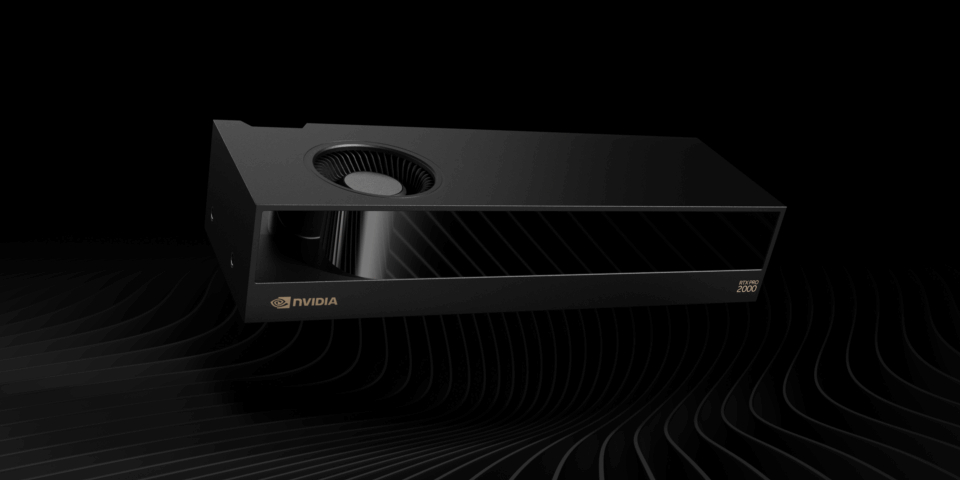NVIDIA unveils two compact new RTX PRO Blackwell GPUs

The 16GB RTX PRO 2000 Blackwell: one of two new small-form-factor GPUs for graphics workstations based on NVIDIA’s current Blackwell architecture announced by the firm this week.
NVIDIA has unveiled the RTX PRO 4000 Blackwell SFF and RTX PRO 2000 Blackwell GPUs.
The new GPUs – both dual-slot, half-height cards – round out the bottom end of the RTX PRO Blackwell series, NVIDIA’s range of professional GPUs based on its Blackwell architecture.
NVIDIA pitches the GPUs, which will become available later this year, as compact, energy-efficient cards suitable for “engineering, design, content creation, AI and 3D visualization”.
Below, we’ve rounded up their key specs for DCC work, and what we know about their likely performance in CG software.
| NVIDIA Blackwell workstation GPUs | |||||||
|---|---|---|---|---|---|---|---|
| RTX PRO 6000 Blackwell W/E |
RTX PRO 6000 Blackwell MaxQ W/E |
RTX PRO 5000 Blackwell |
RTX PRO 4500 Blackwell |
RTX PRO 4000 Blackwell |
RTX PRO 4000 Blackwell SFF |
RTX PRO 2000 Blackwell |
|
| Architecture | Blackwell | Blackwell | Blackwell | Blackwell | Blackwell | Blackwell | Blackwell |
| CUDA cores | 24,064 | 24,064 | 14,080 | 10,496 | 8,960 | 8,960 | 4,352 |
| Tensor cores | (752) | (752) | (440) | (328) | (280) | (280) | (136) |
| RT cores | (188) | (188) | (110) | (82) | (70) | (70) | (34) |
| Compute performance FP32 (Tflops) |
125 TFlops | 110 TFlops | 65 TFlops | (51 TFlops) | (47 TFlops) | (24 TFlops) | 17 TFlops |
| GPU memory | 96GB GDDR7 |
96GB GDDR7 |
48GB GDDR7 |
32GB GDDR7 |
24GB GDDR7 |
24 GB GDDR7 | 16 GB GDDR7 |
| Memory bandwidth | 1,792 GB/s | 1,792 GB/s | 1,344 GB/s | 896 GB/s | (672 GB/s) | 432 GB/s | 288 GB/s |
| Graphics bus | PCIe 5.0 x16 | PCIe 5.0 x16 | PCIe 5.0 x16 | PCIe 5.0 x16 | PCIe 5.0 x16 | PCIe 5.0 x8 |
PCIe 5.0 x8 |
| TDP | 600W | 300W | 300W | 200W | 140W | 70W | 70W |
| Display connectors | 4 x DP 2.1 | 4 x DP 2.1 | 4 x DP 2.1 | 4 x DP 2.1 | 4 x DP 2.1 | 4x MiniDP 2.1 | 4x MiniDP 2.1 |
| Size (H x L) | 5.4” x 12.0” Dual slot |
4.4” x 10.5” Dual slot |
4.4” x 10.5” Dual slot |
4.4” x 10.5” Dual slot |
4.4” x 9.5” Single slot | 2.7” x 6.6” Dual slot | 2.7” x 6.6” Dual slot |
| Launch date | 2025 | 2025 | 2025 | 2025 | 2025 | Late 2025 | Late 2025 |
| Launch MSRP | ($8,565) | ($8,565) | ($4,569) | ($2,623) | ($1,546) | ($1,546) | ($722) |
Figures in brackets are taken from third-party websites. Prices are from US reseller Connection, as reported by VideoCardz.com. W/E refers to the Workstation Edition.
Key specifications for CG work
NVIDIA has been oddly inconsistent with the data it has announced for the RTX PRO Blackwell GPUs: for example, the data sheet for the RTX PRO 2000 Blackwell includes a figure for single-precision compute performance, while the one for the RTX PRO 4000 Blackwell SFF does not.
However, you can see the key specs for the new cards in the table above, with NVIDIA’s own figures supplemented by those from third-party websites like TechPowerUp.
Most are in line with what you would expect compared to the higher-end cards in the RTX PRO Blackwell range.
The key point of differentiation is that both are dual-slot, half-height cards intended for small-form-factor workstations, with much lower power needs than their beefier counterparts.
As far as we’re aware, NVIDIA hasn’t announced recommended pricing for any of the RTX PRO Blackwell GPUs, so the prices in the table are based on figures from US enterprise-focused reseller Connection, as reported in the tech press earlier this year.
They date from before the RTX PRO 4000 Blackwell SFF and RTX PRO 2000 Blackwell were officially announced, so treat them with caution, but they give an idea of the likely relative costs.
How will the RTX PRO Blackwell GPUs perform with CG software?
According to NVIDIA, the RTX PRO 2000 Blackwell offers “up to 1.6x faster 3D modeling, 1.4x faster CAD performance and 1.6x quicker rendering” compared to its previous-gen counterpart, the RTX 2000 Ada Generation.
However, it doesn’t say how those figures were calculated, and – as with the other RTX PRO Blackwell GPUs – the launch announcement does not include benchmarks for CG applications.
The closest is a quote from engineering consultancy Thornton Thomasetti, which says that its in-house GPU-based Finite Element Analysis solver is “almost 3x faster” on the RTX PRO 2000 Blackwell than the RTX 2000 Ada Generation.
Prices and release dates
The RTX PRO 4000 Blackwell SFF and RTX PRO 2000 Blackwell will be available “later this year” via PNY and TD SYNNEX, and via workstation manufacturers like BOXX, Dell, HP and Lenovo.
NVIDIA hasn’t announced official recommended prices for the new GPUs.
Read NVIDIA’s announcement of the new RTX PRO Blackwell series GPUs
Find specifications for the RTX PRO Blackwell desktop GPUs on NVIDIA’s website
Have your say on this story by following CG Channel on Facebook, Instagram and X (formerly Twitter). As well as being able to comment on stories, followers of our social media accounts can see videos we don’t post on the site itself, including making-ofs for the latest VFX movies, animations, games cinematics and motion graphics projects.
